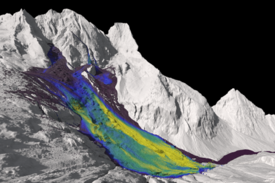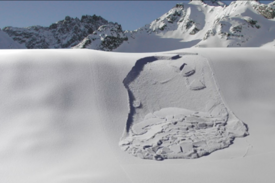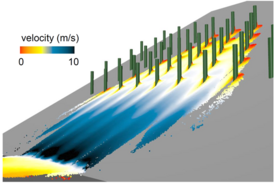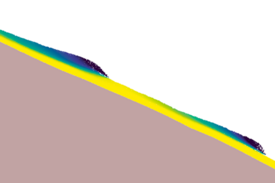
Alpine Mass Movements ¶
Head: Prof. Dr. Johan Gaume
The Alpine Mass Movement research group investigates the mechanics of gravitational mass movements occurring in mountain environments and contributes to mitigation and land-use planning solutions. Processes of interest include avalanches, debris flows and rockfalls. The group develops and uses advanced computational methods as well as physics-based practice-oriented approaches, supported by laboratory and field experiments to better understand and predict the triggering phase and dynamics of mass movements. Particular attention is devoted to understanding and addressing climate change impacts and potentially catastrophic cascading processes.
The new group Alpine Mass Movements covers one of the six main topics of the CERC research centre. The group is operated together with the chair of Alpine Mass Movements at ETH Zürich in the framework of a joint professorship by Johan Gaume. Teaching at ETH Zürich by Prof. Gaume includes “Granular Mechanics” (start fall 2023) and “Alpine Mass Movements” (start spring 2025).
Brief insight into our research activities ¶
Modeling cascading alpine mass movements ¶

Exceptional mountain instabilities can trigger complex process chains involving rock, ice, snow avalanches and outburst flows. To better understand, simulate and manage such events, we develop a thermo-hydromechanical Material Point Method that simulates the mechanical behavior of different materials and their interaction, friction heat dissipation, phase changes as well as the effect pore pressure induced fluidization.
Shallow landslides and avalanche release mechanisms ¶

To shed light on release mechanisms of shallow landslides and in particular of snow slab avalanches, we develop particle-based models such as the Discrete Element Method (DEM), the Material Point Method (MPM) or the depth-averaged MPM (DAMPM). Particular attention is devoted to decipher the link between crack propagation dynamics at the slope scale, topography and the size of the release zone and eventually propose mitigation solutions to reduce the avalanche volume.
Cohesive granular flows: rheology, dynamics and impact ¶

We study the rheology of cohesive granular flows and their impacts on structures or forests, by performing different types of mesoscale DEM simulations. These simulations can be viewed as numerical laboratory that can support the development of homogenized constitutive models for cohesive granular flows for large-scale MPM implementations. Additionally, we develop a laboratory chute for granular flow experiments over complex, 3D printed topographies.
Erosion mechanisms in alpine mass movements ¶

Erosion and entrainment are critical processes in gravity-driven mass flows like snow as they can significantly change the flow mass and momentum and thus affect the flow dynamics. We investigate these processes by means of DEM, CFD/DEM or MPM simulations in the case of cohesionless, cohesive but also (air or water) saturated granular beds. Our findings contribute to improve related parametrizations in large-scale avalanche dynamics models.
Multimedia ¶
Staff ¶
Alpine Mass Movements
Group leader / Joint Professorship |
|
PhD student |
|
Scientific staff member |
|
PhD student |
|
PhD student |
|
PhD student |
|
PhD student guest |
|
PhD student |
|
PhD student |
|
PhD student |
|
Administrative staff member |
|
Master student |
|
Scientific staff member |
|
PhD student guest |
|
Visiting scientist |